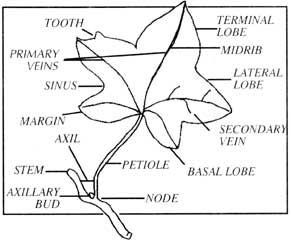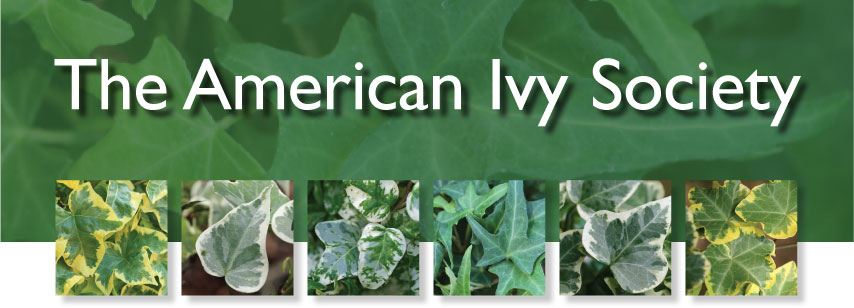The Care of Ivies
Ivy 101

IVY TERMINOLOGY
AXIL - angle between stem and Petiole.
BASAL LOBES - two lower projections at base of leaf closest to the leaf stalk.
LATERAL LOBES - large projections at the side of leaf, next to the terminal lobe.
LEAF BLADE - flattened portion of the leaf.
MARGIN - the edge of the leaf blade; in some ivies it may be curled under, tightly curled (fluted), or undulate (wavy up and down).
MIDRIB - central vein running from petiole to leaf tip.
NODE - point at which leaf stalk is attached to stem.
PETIOLE - leaf stalk, extends from stem to leaf blade.
PRIMARY VEINS - the most prominent veins of a leaf.
SECONDARY VEINS - those veins which depart from the primary veins; they may or may not extend to the leaf margin.
SINUS - angle or valley between two lobes; may be rounded or angular.
STEM - main branch of plant.
TERMINAL LOBE - central projection at far end of leaf blade, opposite leaf stalk.
TOOTH, TEETH (pl.) - minor projections along the margin of the leaf.
VEIN - vascular tissue (water and food carrying tubes) in the leaf; the tubes are compressed together in the petiole then diverge out from the base of the leaf to tips of the lobes.
AN INTRODUCTION TO IVIES
Ivies are an exciting group of vining plants that are gaining more attention these days! The English ivy, Hedera helix, is perhaps best known for its evergreen foliage that is often used as a groundcover year-round. Its foliage is also capable of clothing brick or stone walls and fences.
In addition to the English ivy, Hedera helix, there are a number of other species of true ivy. The best known are: Hedera colchica, which has a form, 'Dentata', that is widely used as a groundcover in hardiness zone 5 and southward. Hedera canariensis, the Algerian or Canary ivy, sometimes known as Hedera algeriensis, it also comes in a variegated form called 'Gloire de Marengo'. Hedera rhombea, the Japanese ivy, is native to Japan. Hedera nepalensis, the Nepal ivy, is found in the Himalayas, Afghanistan and western China. Hedera pastuchovii, (Russian Ivy), is an Asiatic species native to the Caucasus Mts. near the Black Sea.
But some plants called ivy are really not ivies at all. The Boston ivy, which is used in northern climates to cover buildings, belongs to the genus Parthenocissus, turns red in the fall and loses its leaves. It is not evergreen. Most of the other plants labeled as ivies are plants of tropical origin and are commonly used as houseplants. This group of so-called ivies includes: grape-ivy (Cissus rhombifolia), German-ivy (Senecio mikanioides), Swedish-ivy (Plectranthus oertendahlii), and Kenilworth-ivy (Cymbalaria muralis). Poison-ivy (Rhus toxicodendron) is also not a true ivy.
Ivy Care
WATERING
Water thoroughly but infrequently. When the soil feels dry, gently add water to the soil until the surface is totally wet and the water drains out of the bottom of the pot. Then do not water again until the soil is almost dry. Do not allow pots to stand continually in water.
If the air is dry, raise the humidity surrounding the plants by grouping ivies together on a tray full of wet pebbles or perlite, but do not allow the ivies to stand in water.
LIGHT
Ivies are remarkably tolerant to a wide range of light conditions. But in the home a south or west window can be quite drying especially in summer. A north or east window or filtered or reduced light from a south or west window is satisfactory. Ivies respond well to artificial fluorescent light conditions. Place your plants 6" to 10" from the fluorescent tubes.
In temperate climates ivies may be summered outdoors in the shade. In warmer parts of the country potted ivies will do well outdoors as well as indoors. Never put indoor plants outdoors where they will receive any direct sun.
FERTILIZING
Since foliage is the main feature of ivies, use fertilizers high in nitrogen (the first number in the fertilizer formulation) to provide good green growth. Apply fertilizer to soil only, since foliar absorption would be minimal, or may even be harmful, under indoor conditions.
In the home, feed actively growing ivies monthly with any foliage houseplant fertilizer, according to the manufacturer's directions. Do not use fertilizer when plants stop growing either in the heat of summer, or when temperatures are cool.
POTTING
When the plant becomes top heavy, root bound, or dries out too rapidly, it is time to repot. Put ivies into slightly larger pots, just large enough to hold the roots. Over-potting, or use of too large a pot for the size of the root system, and inadequate pot drainage can lead to root rot. Use either plastic or clay pots, depending on your watering schedule. (Clay pots dry out faster!) Be sure there is an adequate number of drainage holes that are at least 1/4" in diameter.
Always transplant into moist soil. If you water your plants frequently, use a commercially available, soilless mix which drains and dries readily. If you like a heavier mix which needs watering less frequently, make your own by using 1 part commercially available sterilized topsoil, 1 part Canadian sphagnum peat moss and 1 part perlite. Heavy, water-logged soils result in poor plant growth and make the plants less resistant to insect attack.
Loosen the root ball with a dull knife, or use your fingers. Lightly cover holes in the bottom of the pot with screening, old nylon hosiery, or clay pot fragments - anything to prevent soil from washing out of the pot without hindering water movement. Place a small amount of fresh soil mix into the new pot, spread the roots out, and continue to fill soil around the roots to just below the rim. Then water gently, until water drains out of the pot. Always soak clay pots first before adding plants; otherwise the dry, porous clay will act like a wick to draw moisture from the soil.
PEST CONTROL
There is no need to use expensive chemical controls on just a few pots of ivy. Most pest problems in the home can be prevented or controlled by periodic washing (see instructions below), or by spraying with luke warm water. Washing removes dirt, dust, and insects. Remove dead leaves to prevent the spread of disease. Cut off insect-infested parts of the plant. Once insect or disease damage has occurred, damaged tissue cannot be healed, only covered up by new foliage, or removed. If the treatment has been satisfactory, new growth will be unblemished. Ivies grow quickly and will soon fill in the bare spots.
Ivies, as compared to many other ornamentals, suffer from relatively few problems. But many of the problems can be prevented, minimized, or remedied by washing the ivies.
Frequently dunk the foliage in a gallon of water to which a few drops of dishwashing detergent have been added; for delicate plants, rinse thoroughly in a spray of warm water. Prevent soil from falling out of the pot while dunking by putting foil over the soil or encasing only the pot in a plastic bag and fastening the plastic around the stems.
The most common ailment is spider mite infestation. Spider mites thrive in the warm, dry, home environment. Spider mite damage is recognized in the earliest stages by pinpoint yellow speckles on older foliage toward the base of the stems. Those leaves then turn yellow; in advanced stages the webs develop over the leaves and stems, and leaves become brown, shriveled, and dried out.
Several washings may be necessary to control spider mite. Repeat 3 times, once every 5-7 days. Raising the humidity (see "Watering") and lowering the air temperature can also reduce spider mite problems by making the environment less hospitable to these pests.
Only as a last resort, use a miticide labeled for ivy. Take the pot outdoors or at least into an open garage, away from food, pets, and children. Never apply pesticides in the kitchen. Use rubber gloves, wear long sleeves, and follow the manufacturer's direction. Do not use greater than recommended concentrations of any insecticide or pesticide; it can be toxic to both you and the plant. More is not better.
Another common ivy houseplant insect problem is scale. This insect infestation appears as brown, waxy mounds on leaves, often appearing on the under surface. Eventually these leaves become pale and fall off. Control scale by wiping the leaves with 70% alcohol and then rinsing the residue off with warm water.
In the greenhouse or in large collections, you may encounter other problems. Aphids are insects, often black, gray, or pale green, that attack tender young shoots and secrete a sticky honeydew which drops on the foliage below. This honeydew attracts ants or other insects as well as a black fungus in advanced stages. Cut off the infested shoots and wash the remainder of the plants in the manner described above.
Cyclamen mites cause deformed, puckered new growth. Not much can be done. It's best to throw out the plant.
Mealy bugs develop through several phases from pale, smooth oval specks to large (3 mm long) white, cottony mounds. Mealy bugs are often first found on the underside of stems at the point where the leaves are attached. Control mealy bugs by wiping the leaves with 70% alcohol and then rinsing.
You may also encounter white fly. You can recognize it in advanced stages as whitish cylindrical specks on the under surface of the leaves. The specks seem to flit around when the leaves are disturbed.
Outdoors, or in hot summer greenhouses, leaf spot may be a problem under conditions involving any combination of these factors: high humidity, high or low temperatures, poor air circulation, and wet soils. Leaf spots can be caused by a fungus or bacteria. The spots are dark, circular and sometimes are bordered by a lighter ring; or the leaf margins turn dark and then dry. Leaf spot can be controlled by improving air circulation and avoiding wetting the foliage. Using chemicals is marginally effective against leaf spot diseases.
If any pest problem is exceptionally severe, it may be better to throw away the plant, pot and all, and start over. If you are desperate and need to save the plant and if washing is impractical, check with your county agent for an approved spray; follow the manufacturer's directions.
